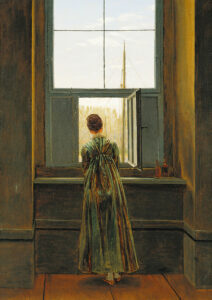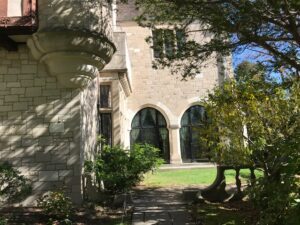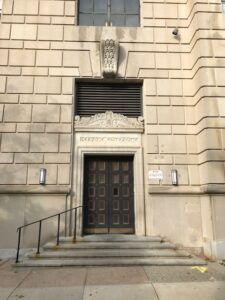Witold Rybczynski's Blog, page 10
December 8, 2021
RULES OF THUMB

Caspar David Friedrich, Woman at a Window, 1822
At a time when most schools of architecture have courses in what is referred to as “history-theory,” I was struck by a sentence in Laurie Olin’s forthcoming collection, Essays on Landscape. “Contrary to many architects I knew, I believed that theory is developed in retrospect, to account for what had been or was being done in the field, and that it rarely preceded of led creative practice.” Just so. Some buildings are, in a sense, experiments, and when something works, and is taken up by others, it eventually becomes a rule of thumb, perhaps even a theory. Christopher Alexander’s Pattern Language is full of rules of thumb: rooms are nicer when they have windows on at least two sides; vary ceiling heights; a staircase can be a stage. Such rules develop from observation, which is why architectural training has traditionally included travel—it’s important to see things for yourself, and especially to see those seminal buildings that have given rise to rules of thumb—Bramante’s Tempietto, Schinkel’s Altesmuseum, Gehry’s Bilbao. Architecture resembles engineering in that practice leads theory, not vice versa. First you build a flying machine, and later you discover the aerodynamic theory that supports flight.
The post RULES OF THUMB first appeared on WITOLD RYBCZYNSKI.
November 20, 2021
GOING ON
 Years ago, when Shirley and I lived in Quebec, we regularly took a few days off during the winter to stay at a country inn in the Laurentians, north of Montreal. It was run by a German family, and the hearty food—schnitzel and kartoffelklöße—was a big part of the attraction. So was the cross-country skiing. We could ski out of the front door of our house in Hemmingford, but it was quite flat so hilly terrain was more fun. The trails were long and the area was quite wild. One day we went out, and after several hours I had to admit that we were quite lost. It was the end of the afternoon and getting cold. We soldiered on. At one point I felt very tired and just wanted to lie down and rest. Just for a short time, I said. Shirley would have none of it. She scolded me, and made me get up. We finally made it back to the inn at nightfall; I think they were about to send out a search party.
Years ago, when Shirley and I lived in Quebec, we regularly took a few days off during the winter to stay at a country inn in the Laurentians, north of Montreal. It was run by a German family, and the hearty food—schnitzel and kartoffelklöße—was a big part of the attraction. So was the cross-country skiing. We could ski out of the front door of our house in Hemmingford, but it was quite flat so hilly terrain was more fun. The trails were long and the area was quite wild. One day we went out, and after several hours I had to admit that we were quite lost. It was the end of the afternoon and getting cold. We soldiered on. At one point I felt very tired and just wanted to lie down and rest. Just for a short time, I said. Shirley would have none of it. She scolded me, and made me get up. We finally made it back to the inn at nightfall; I think they were about to send out a search party.
That’s what she would tell me today. “Now, go on.”
The post GOING ON first appeared on WITOLD RYBCZYNSKI.
November 9, 2021
MEMORIES
 Last week I visited Planting Fields, a Jazz Age estate on Long Island’s Gold Coast. The house was completed in 1921, designed by Alexander Stewart Walker (1876–1952) and Leon Narcisse Gillette (1878–1945), whose Manhattan firm was responsible for several Long Island country houses. The style of the house is usually described as Tudor Revival. Walking around the sprawling mansion I was reminded why historical revival styles were so popular for so long. To begin with, the house is not really a recreation of a particular historical period. There are half-timbered parts, limestone parts, and an entry that reminded me of Christopher Wren. This picturesque variety achieves several goals. It breaks down the scale. A 67-room house risks feeling like a small hotel, and chopping it up into bite-sized portions preserves a domestic atmosphere that while hardly cosy, is certainly comfortable. It also allows architectural variety on the interior, which includes a medieval gallery, a French Rococo sitting room, a lighthearted bedroom designed by Elsie de Wolfe, and a breakfast room with a buffalo themed mural by Robert Winthrop Chanler that defies easy stylistic categorization. It is a common mistake to think of revival styles as a reproduction of something. Instead, they are more like a rough framework for memories, real and imagined In the case of Planting Fields, the framework resonated with the owners. William Coe was born in England (he arrived with his parents when he was ten, and worked his way up from office boy in an insurance office to president of the firm). His wife Mai, a wealthy heiress (daughter of Standard Oil founder, Henry “Hell Hound” Rogers) also had a British connection—the house was inspired by the English Tudor manor house that belonged to her sister. We live in an age when architectural conformity—and consistency—is the rule, and when looking backward is considered retardataire. More’s the pity.
Last week I visited Planting Fields, a Jazz Age estate on Long Island’s Gold Coast. The house was completed in 1921, designed by Alexander Stewart Walker (1876–1952) and Leon Narcisse Gillette (1878–1945), whose Manhattan firm was responsible for several Long Island country houses. The style of the house is usually described as Tudor Revival. Walking around the sprawling mansion I was reminded why historical revival styles were so popular for so long. To begin with, the house is not really a recreation of a particular historical period. There are half-timbered parts, limestone parts, and an entry that reminded me of Christopher Wren. This picturesque variety achieves several goals. It breaks down the scale. A 67-room house risks feeling like a small hotel, and chopping it up into bite-sized portions preserves a domestic atmosphere that while hardly cosy, is certainly comfortable. It also allows architectural variety on the interior, which includes a medieval gallery, a French Rococo sitting room, a lighthearted bedroom designed by Elsie de Wolfe, and a breakfast room with a buffalo themed mural by Robert Winthrop Chanler that defies easy stylistic categorization. It is a common mistake to think of revival styles as a reproduction of something. Instead, they are more like a rough framework for memories, real and imagined In the case of Planting Fields, the framework resonated with the owners. William Coe was born in England (he arrived with his parents when he was ten, and worked his way up from office boy in an insurance office to president of the firm). His wife Mai, a wealthy heiress (daughter of Standard Oil founder, Henry “Hell Hound” Rogers) also had a British connection—the house was inspired by the English Tudor manor house that belonged to her sister. We live in an age when architectural conformity—and consistency—is the rule, and when looking backward is considered retardataire. More’s the pity.
The post MEMORIES first appeared on WITOLD RYBCZYNSKI.
October 29, 2021
JUST A SERVICE ENTRANCE
 I think it was Christopher Alexander who I once heard observe that everything in our surroundings—everything—either raises our spirits or dampens them. It may only be a notch or two, but every thing we look at makes us feel either slightly better or slightly worse. My afternoon walk often takes me past the rear of the Board of Education Building in Philadelphia, and a detail in that building always gives me a lift. It’s the service entrance. I know that’s what it is because the name is elegantly carved into the stone door frame. The building was designed in 1930 in a style sometimes called Moderne, a fusion of Classicism with Art Deco, and the pediment above the doorway reflects this aesthetic. Is there any doubt that a service entrance designed in 2021 would be very different? The pioneers of modernism, who would scoff at the ornamental bracket and the paneled and studded door, bear a heavy responsibility. Not only did they put blinders on designers so that the past became forbidden—and forgotten—territory. They provided permission to mediocre talents to produce and even celebrate mediocrity. The designer of the service entrance that I admire, Irwin Thornton Catharine (1884-1944), was not a celebrated architect; he didn’t attend the Ecole des Beaux-Arts, or even a university (he had a Certificate in Architecture from the Drexel Institute of Art, Science and Industry). But he had a long and deep tradition to draw on, and a toolbox of design skills to deploy. He produced not a utilitarian door surrounded by a skimpy frame, but something solid and weighty, something beautiful, something to raise the spirits. Thank you Irwin.
I think it was Christopher Alexander who I once heard observe that everything in our surroundings—everything—either raises our spirits or dampens them. It may only be a notch or two, but every thing we look at makes us feel either slightly better or slightly worse. My afternoon walk often takes me past the rear of the Board of Education Building in Philadelphia, and a detail in that building always gives me a lift. It’s the service entrance. I know that’s what it is because the name is elegantly carved into the stone door frame. The building was designed in 1930 in a style sometimes called Moderne, a fusion of Classicism with Art Deco, and the pediment above the doorway reflects this aesthetic. Is there any doubt that a service entrance designed in 2021 would be very different? The pioneers of modernism, who would scoff at the ornamental bracket and the paneled and studded door, bear a heavy responsibility. Not only did they put blinders on designers so that the past became forbidden—and forgotten—territory. They provided permission to mediocre talents to produce and even celebrate mediocrity. The designer of the service entrance that I admire, Irwin Thornton Catharine (1884-1944), was not a celebrated architect; he didn’t attend the Ecole des Beaux-Arts, or even a university (he had a Certificate in Architecture from the Drexel Institute of Art, Science and Industry). But he had a long and deep tradition to draw on, and a toolbox of design skills to deploy. He produced not a utilitarian door surrounded by a skimpy frame, but something solid and weighty, something beautiful, something to raise the spirits. Thank you Irwin.
The post JUST A SERVICE ENTRANCE first appeared on WITOLD RYBCZYNSKI.
October 17, 2021
A PAST WORTH SAVING
 The historic preservation movement, as I think Vincent Scully once pointed out, was the most powerful expression of public interest in architecture of the twentieth century. But the truth is that the historic preservation movement was not really about preserving the past; people did not want to save Penn Station because it was old, or because it was an expression of a particular era. They wanted to save it because it was beautiful, beautifully conceived and beautifully built. The four decades between 1900 and 1940 were a magical period in American architecture. Comparable, as Augustus Saint-Gaudens observed, to the Italian Renaissance—a perfect joining of money, patronage, taste, and skills. As Charles McKim showed at Penn Station, you could solve a modern problem like a railroad station without renouncing the past, indeed, that past made the modern solution all the more convincing.
The historic preservation movement, as I think Vincent Scully once pointed out, was the most powerful expression of public interest in architecture of the twentieth century. But the truth is that the historic preservation movement was not really about preserving the past; people did not want to save Penn Station because it was old, or because it was an expression of a particular era. They wanted to save it because it was beautiful, beautifully conceived and beautifully built. The four decades between 1900 and 1940 were a magical period in American architecture. Comparable, as Augustus Saint-Gaudens observed, to the Italian Renaissance—a perfect joining of money, patronage, taste, and skills. As Charles McKim showed at Penn Station, you could solve a modern problem like a railroad station without renouncing the past, indeed, that past made the modern solution all the more convincing.
The post A PAST WORTH SAVING first appeared on WITOLD RYBCZYNSKI.
October 15, 2021
A GOOD CAUSE
 Home: A Celebration, just published by Rizzoli, is a beautiful book in a good cause; it’s a fundraiser for No Kid Hungry. The interior decorator Charlotte Moss has brought together essays, poems, sketches, and photographs by a variety of authors, including Joyce Carol Oates, Isaac Mizrahi, Annie Leibovitz, Julian Fellowes, Bette Midler, John Grisham, and Alice Waters. There are a few architects, too: Marc Appleton, Michael Imber, Tom Kligerman. And yours truly.
Home: A Celebration, just published by Rizzoli, is a beautiful book in a good cause; it’s a fundraiser for No Kid Hungry. The interior decorator Charlotte Moss has brought together essays, poems, sketches, and photographs by a variety of authors, including Joyce Carol Oates, Isaac Mizrahi, Annie Leibovitz, Julian Fellowes, Bette Midler, John Grisham, and Alice Waters. There are a few architects, too: Marc Appleton, Michael Imber, Tom Kligerman. And yours truly.
The post A GOOD CAUSE first appeared on WITOLD RYBCZYNSKI.
September 29, 2021
MISPRINT
 A breathless article in the New York Times writes: “Mr. Hernández and his family are moving to a new home on the outskirts of Nacajuca, Mexico: a sleek, 500-square-foot building with two bedrooms, a finished kitchen and bath, and indoor plumbing. What’s most unusual about the home is that it was made with an 11-foot-tall three-dimensional printer.” Housing crisis? No problem, high tech comes to the rescue! The report is rather sparse on details, but as far as I can make out, the 3D printer spits out the walls and partitions using “Lavacrete,” a concrete-like material. That’s it; the foundations, concrete slab, roof, doors, windows, the “finished kitchen and bath, and indoor plumbing,” and so on, are produced conventionally, so it’s hard to see where the vaunted savings come in. Even if the walls are cheaper—which is far from clear—that would make a minuscule dent in the overall price of the house. In a North American production home, total construction cost accounts for only about one quarter of the selling price, depending on land cost. One quarter.
A breathless article in the New York Times writes: “Mr. Hernández and his family are moving to a new home on the outskirts of Nacajuca, Mexico: a sleek, 500-square-foot building with two bedrooms, a finished kitchen and bath, and indoor plumbing. What’s most unusual about the home is that it was made with an 11-foot-tall three-dimensional printer.” Housing crisis? No problem, high tech comes to the rescue! The report is rather sparse on details, but as far as I can make out, the 3D printer spits out the walls and partitions using “Lavacrete,” a concrete-like material. That’s it; the foundations, concrete slab, roof, doors, windows, the “finished kitchen and bath, and indoor plumbing,” and so on, are produced conventionally, so it’s hard to see where the vaunted savings come in. Even if the walls are cheaper—which is far from clear—that would make a minuscule dent in the overall price of the house. In a North American production home, total construction cost accounts for only about one quarter of the selling price, depending on land cost. One quarter.
The post MISPRINT first appeared on WITOLD RYBCZYNSKI.
September 21, 2021
COMFORT

Zig-Zag Chair, Gerrit Rietveld, 1930s
“And really, isn’t that what design is meant to do? Challenge us, provoke us, unsettle our expectations. Comfort is welcome. But discomfort can be, too,” concludes a recent editorial in the New York Times’ T Magazine. Oh, really? That’s what design is meant to do? A certain kind of architect and designer—or in this case, magazine editor—considers comfort to be the equivalent of complacency. Or is this just a rationalization, a way to justify exposing concrete, painting surfaces black, leaving out upholstery? No one should confuse comfort with good design; comfort is not sufficient, but it is required. And it is difficult. Much easier to “challenge, provoke, and unsettle,” and pretend that “discomfort is welcome.” What rubbish.
The post COMFORT first appeared on WITOLD RYBCZYNSKI.
September 5, 2021
INSTRUCTION AND INSPIRATION

Smith House (Richard Meier), 1965-67
A reader recently wrote to me citing Frank Lloyd Wright as a model for the future. “Wright’s discipline itself offers us an antidote to the wandering efforts of rudderless students: it can be understood and undertaken by those with a little personal aptitude and a readiness for hard work to design buildings of real point, character, freshness, and charm.” How likely is a Wright Revival? Historical examples of revivals abound: Inigo Jones revived Palladio, Wren revived Bramante, Lutyens revived Wren. More recently, Richard Meier launched his career by reviving early Corbusier, Tadao Ando learned a lot from Kahn, and Thomas Phifer has revisited Mies. What is striking about the revivalists cited above is that they are all architects of the first rank who found inspiration in the work of an earlier master. Inspiration, not instruction. The reason that a Wright Revival is unlikely is that his work and writings are didactic—my way is the right way, the only way—which tends to produce disciples and followers, but does not necessarily inspire independent creative talents. The successful model for a revival is capacious, opening doors rather than setting limits, acting as a springboard rather than a template.
The post INSTRUCTION AND INSPIRATION first appeared on WITOLD RYBCZYNSKI.
August 31, 2021
MOXIE
 It is eight weeks to the day since Shirley died. I still can’t get used to saying “I” and “mine” rather than “we” and “our.”
It is eight weeks to the day since Shirley died. I still can’t get used to saying “I” and “mine” rather than “we” and “our.”
I look at old photographs a lot. This is one when she was a student in a convent school with the sisters of the Congrégation de Notre-Dame in Montreal. She is ten and all her best qualities are already in evidence in her forthright gaze: good humor, realism, intelligence, fortitude. And moxie—she is fearless.
The post MOXIE first appeared on WITOLD RYBCZYNSKI.
Witold Rybczynski's Blog
- Witold Rybczynski's profile
- 178 followers



